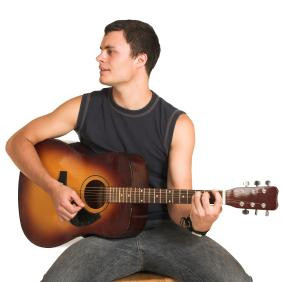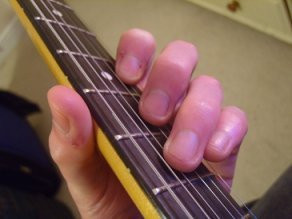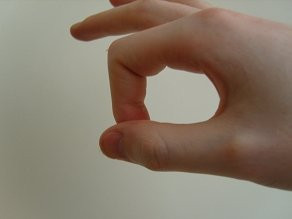It might seem like an obvious starting point, but understanding how to properly hold your guitar is the foundational step every beginner guitarist needs to master before diving into chords and strumming techniques. This guide applies to both electric and acoustic guitars. While acoustic guitars are often bulkier, the core principles of holding the instrument remain consistent for both types.
If there’s one piece of advice to burn into your memory every time you pick up a guitar, it’s this: avoid hunching!
Developing a habit of hunching over your guitar is incredibly common, yet it’s a detrimental practice. Poor posture can lead to discomfort, muscle strain, and even long-term back problems. Prioritizing correct posture from the outset is an investment in your playing longevity and overall comfort.
Let’s explore the correct way to hold a guitar while seated:
Optimal Sitting Position for Guitar Playing
 Man seated holding an acoustic guitar, right leg slightly raised, guitar resting comfortably, straight back. Man seated holding an acoustic guitar, right leg slightly raised, guitar resting comfortably, straight back. |
A standard sitting posture involves having your legs slightly open. In this image, the guitar rests on the guitarist’s right leg because he strums with his right hand, indicating he is right-handed. The guitar body is positioned comfortably just below chest level. Crucially, his back is straight, promoting good posture. His left arm, the one fretting the strings, is at a right angle, minimizing wrist strain when reaching across the fretboard to press down on the strings. This position encourages relaxed and efficient playing. |
|---|---|
 Woman sitting cross-legged holding a guitar, left arm at an acute angle, right elbow positioned at the guitar's top corner. Woman sitting cross-legged holding a guitar, left arm at an acute angle, right elbow positioned at the guitar's top corner. |
Many guitarists find crossing their legs, as demonstrated here, a more comfortable alternative. If you are right-handed and strum with your right arm, crossing your right leg might feel more natural. Her left arm forms a more acute angle compared to the previous image, which is perfectly acceptable as she can comfortably reach all strings on the fretboard. The key principle is to ensure your fretting arm is not at an angle greater than 90 degrees, as this can introduce unnecessary wrist strain. Observe how the elbow of her strumming arm (right arm) is positioned near the top corner of the guitar body. This placement acts as a smooth pivot point, allowing for fluid strumming motions across the soundhole or the first pickup on an electric guitar. |
 Electric guitar tilted slightly towards the player for better fretboard visibility. Electric guitar tilted slightly towards the player for better fretboard visibility. |
This guitarist has slightly tilted his electric guitar inwards, towards his body. This adjustment provides a clearer view of the fretboard, which can be helpful, especially for beginners. While eventually, you’ll rely less on visually monitoring the fretboard, tilting the guitar in this manner is a valid technique to enhance visibility and comfort during the learning phase. The slight tilt should not compromise the fundamental posture principles. |
 Guitarist sitting on the ground holding a classical guitar with proper posture. Guitarist sitting on the ground holding a classical guitar with proper posture. |
Playing guitar while sitting on the ground is also a viable option. Again, the leg positioning is arranged to elevate the guitar body to chest height or just below, preventing hunching. The strumming or picking arm maintains the optimal “top corner” position, ensuring efficient movement. This demonstrates the adaptability of good posture across different seating arrangements. |
 Man foolishly sitting on railway tracks playing guitar, showcasing excellent posture despite unsafe location. Man foolishly sitting on railway tracks playing guitar, showcasing excellent posture despite unsafe location. |
This image depicts a guitarist sitting on railway tracks – a decidedly unsafe location and not recommended! However, despite the poor choice of location, his posture is commendable. He demonstrates a straight back, reinforcing the importance of postural awareness even in unconventional settings. Let’s focus on the posture, not the location in this example! |
In summary for seated guitar playing:
- Whether your legs are crossed or uncrossed, ensure your knees are positioned high enough to support the guitar at or slightly below chest level. This elevation is key to preventing slouching.
- The ‘waist’ or thinnest part of the guitar body (designed for this purpose) should rest on your lap. Position it on the same side as your strumming hand. For right-handed players, this means resting the guitar on your right leg.
- The guitar back should sit relatively flat against your torso, although a slight tilt towards you for better fretboard view is acceptable. Emphasize slight – avoid extreme angles.
- Maintain a straight back. Hunching is detrimental to posture and playing comfort.
- Your strumming arm’s elbow should point outwards towards the top corner of the guitar body. It should be positioned so your forearm and wrist can pivot smoothly over the strings while simultaneously providing support to the guitar body against your own.
- The arm of your fret hand (the hand pressing the strings) should ideally be at a 90-degree angle or less (acute angle). A more acute angle reduces the wrist strain needed to reach around the fretboard.
Standing Guitar Position: Utilizing a Strap
Once you have a guitar strap, it’s crucial to regularly practice playing while standing. Standing guitar playing presents a distinctly different experience compared to sitting. If you aspire to perform live or play gigs, developing the ability to play comfortably while standing and moving is essential.
Here are examples illustrating correct and incorrect standing guitar posture:
 Man standing holding an electric guitar, neck tilted up, good posture, elbow position correct. Man standing holding an electric guitar, neck tilted up, good posture, elbow position correct. |
This guitarist, radiating “cool,” has tilted the guitar neck upwards for easier fretboard access. This is perfectly acceptable as it doesn’t negatively impact other crucial aspects like elbow positioning or back posture. His fretting arm elbow is at a desirable acute angle (less than 90 degrees), minimizing wrist strain. He maintains a straight back, avoiding hunching. The guitar body is positioned at a comfortable height for both strumming and picking. Observe the strumming arm elbow: it’s forward, square with his body, providing an excellent pivot point for strumming. Subtly, his left leg is slightly bent, providing additional support. If he needs to lean forward for a closer fretboard view, the weight shifts into this slightly lunged leg, preventing the need to hunch over. |
|---|---|
 Woman standing with incorrect guitar posture, strap too loose, hunching, poor elbow and wrist angles. Woman standing with incorrect guitar posture, strap too loose, hunching, poor elbow and wrist angles. |
This image exemplifies what not to do. Several issues are apparent. Firstly, the guitar strap is excessively loose, causing the guitar to hang too low. To compensate, she is forced to hunch over significantly. Secondly, her fretting arm is at an obtuse angle (greater than 90 degrees), likely leading to wrist strain when reaching around the fretboard. Furthermore, her strumming arm is positioned with the elbow pushed back, hindering a smooth pivot point necessary for effective strumming and pick positioning. This posture is inefficient and potentially harmful in the long run. |
Key points for standing guitar posture:
- Avoid excessively loosening your strap. Setting the guitar too low, near your knees, makes it incredibly difficult to properly wrap your fingers around the neck for chord playing. Prioritize playability over perceived “coolness.”
- Generally, position the guitar so your fret hand arm is at a 90-degree angle or less. This angle promotes wrist comfort and efficient fretting.
- Reinforcing again: do not hunch! Maintain a straight back while standing.
- Ensure your forearm is positioned square-on and angled towards the top corner of the guitar body (not tucked behind you). This allows your forearm to pivot smoothly across the strings for strumming and picking.
For a more in-depth visual guide to guitar basics, including acoustic and electric specific techniques, consider exploring resources with professional instructors.
Hand Positioning on the Guitar Neck
Correct hand positioning on the guitar neck is another fundamental aspect for beginners. Proper technique from the start will dramatically simplify chord playing and overall technique development.
Let’s examine the ideal hand position on the guitar neck from different perspectives:
 Thumb curled over the top of the guitar neck, larger hands example. Thumb curled over the top of the guitar neck, larger hands example. |
As illustrated, your thumb should rest comfortably on the back of the guitar neck, generally towards the top edge. Your wrist should be relaxed, avoiding being excessively low or tense. A slight bend in the wrist is natural and acceptable. Overly bending the wrist can lead to discomfort and potential long-term issues. Players with smaller hands might find their thumb positioned more towards the center of the neck’s back. The primary goal is to establish a relaxed and comfortable initial hand position. As you progress to chords, your fingers will move into various positions, but for now, focus on getting comfortable with this general hand placement on the neck. Note: Guitarists with larger hands sometimes find it comfortable to bring their wrist up slightly and curl the top of their thumb over the edge of the neck (as shown in the left-most image). While comfort is paramount, be aware that this thumb-over-the-neck technique might require repositioning the thumb to the center for certain chord shapes. It can also necessitate more thumb movement overall. |
|---|
Correctly Holding the Guitar Pick (Plectrum)
The key to holding a guitar pick is to maintain a relaxed grip, avoiding excessive tightness. The pick needs to flex smoothly over the strings to produce a fluid sound.
Holding the pick between the tips of your index finger and thumb is the most effective method for achieving this flexibility.
| Personally, I prefer to form an elongated circle shape like this…  Front view of the index finger and thumb 'O' shape. |
Front view of the index finger and thumb 'O' shape. |
|—|—|
| With the pick in hand, notice how the straightened thumb provides support to the base of the pick, while the index finger supports it closer to the tip.  Front view of hand holding guitar pick, thumb straight, relaxed grip. |
Front view of hand holding guitar pick, thumb straight, relaxed grip. |
When you progress to lessons on strumming and picking, holding your pick in this relaxed manner will significantly contribute to smoother and more fluid playing. You’ll glide across the strings rather than abruptly hitting them.
Next Steps in Your Guitar Journey
Hopefully, you now have a solid understanding of how to hold a guitar correctly, ensuring your playing isn’t hindered by basic postural errors! You are now ready to move on to other fundamental guitar skills, such as learning to finger chords and mastering basic picking techniques.
Remember to dedicate practice time to both standing and sitting positions. Playing while standing can feel quite different and might initially be more challenging. However, considering the possibility of performing on stage one day makes practicing both positions essential.
| Tweet this! |
|---|
Related Article:
